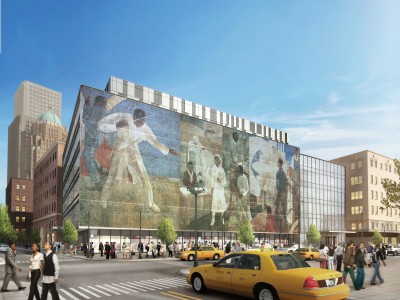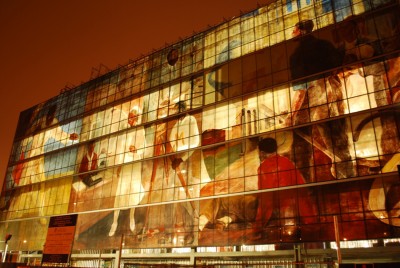Inkjet innovations
As mentioned, direct-to-glass printing can now work just like standard inkjet printing, with designers providing files in either a raster or vector file format, including Tagged Image File Format (TIFF), Joint Photographic Experts Group (JPEG), Portable Document Format (PDF), Adobe Illustrator (AI) and Encapsulated Post Script (EPS) files. Specialty software can process and print low- to high-resolution images, condensing what used to require hundreds of films and screens into files small enough to fit on a Universal Serial Bus (USB) drive.

The Harlem Hospital in New York, N.Y., features a new 20 x 55-mm (65 x 180-ft) mural across its glass façade, comprising 429 panels.
These images can be resized to fit the dimensions of the glass surface, as well as colour-matched. Once the right layout is determined, they can be fused onto the glass from edge to edge. With an inkjet printhead array, multiple colours can be printed at the same time, with the printer processing various designs and handling complicated ‘tiling’ jobs with relative ease. There are no limits to the colour palette or to the degree of opacity.
Then, similar to ceramic frit, a mechanical arm feeds the glass panels into a tempering oven, which uses immense heat to secure the graphics to the glass permanently.
Telling stories in glass
With inkjet technology’s potential to enhance designs for printed glass, some designers and architects have been experimenting with applications of images and text on commercial buildings’ curtain walls, entranceways, office partitions and other glass surfaces. Even residential spaces’ designers are, by way of example, incorporating decorative graphics on shower doors.
The Harlem Hospital in New York, N.Y., features a new 20 x 55-m (65 x 180-ft) mural across its glass facade. The project’s architects at Hellmuth, Obata + Kassabaum (HOK) spent the design phase envisioning how they could depict African-Americans’ historic tale of migration to and across the U.S., using paintings created decades ago and rescaling them to enormous proportions for public display.
Once the HOK architects discovered digital direct-to-glass printing, they knew they had found the right technology for the job. The facade would comprise 429 glass panels, each measuring 1.5 x 3.7 m (5 x 12 ft) and associated with its own graphic printing file. So, in the event of an error or accident, a panel could easily be reproduced.
The painted images were originally created as part of the 1930s Works Progress Administration, portraying life in Harlem, traditional African healing practices, dancing couples, women in conversation and other everyday moments. Now, patients and visitors walk through the hospital’s corridors illuminated with the paintings’ colours, while pedestrians outside on Lennox Avenue stop to admire the mural’s glow.
Stephen Balik is principal of business development for GGI. For more information, visit www.generalglass.com.






